An Energy Portrait-Based Identification Method of Building Users for Demand Response
Abstract
1. Introduction
- Typical load curves can be used to characterize the energy use behavior, and they are often used for individual users. However, there may be millions of customers at the city scale, so this approach is limited to target candidates from numerous and diverse consumers due to large consumption tasks. Additionally, it is hard to closely relate load curves to the demand response program directly.
- Some indicators have been proposed in existing studies. However, they are not sufficient to meet the Chinese electricity market when considering different DR programs, including load shifting and monthly peak shaving. Furthermore, the targeting process is relatively complicated and still relies on typical load curves obtained by clustering.
- In facing numerous users on an urban scale, an energy-efficient selection method is required to quickly identify the potential building users for different DR programs, which is very important for the utility or the load aggregators.
2. Electricity Pattern Characterization and Portrait-Based Identification Method
2.1. Features for User Portrait Description
- (1)
- Energy consumption ratio during the peak period (CRPP): This indicates the energy proportion consumed during the peak period compared to the total energy consumption over the entire analysis period.where Pd is a vector containing the energy consumption for an entire day, Pd,peak is a vector containing the energy consumption during the peak period of a day, D represents the number of days covered by the collected data, and the subscript sum denotes summation.
- (2)
- Energy consumption ratio during the critical peak period (CRCPP): This indicates the energy proportion consumed during the critical peak period compared to the total energy consumption over the entire analysis period.where Pd,critical peak is a vector containing the energy data during the critical peak period of a day.
- (3)
- Energy consumption ratio during the flat period (CRFP): This indicates the energy proportion consumed during the flat period compared to the total energy consumption over the entire analysis period.where Pd,flat is a vector containing the energy consumption data during the flat period of a day.
- (4)
- Energy consumption ratio during the valley period (CRVP): This indicates the energy proportion consumed during the valley period compared to the total energy consumption over the entire analysis period.where Pd,valley is a vector containing the energy consumption data during the valley period of a day.
- (5)
- Peak–valley difference rate (PVDR): This reflects the energy fluctuation during the analysis period. The following equation is an example based on one month.where the subscript max, min, and ave denote the maximum, minimum, and average values, respectively.
- (6)
- Peak demand during the analysis period (PD): This is the scale of energy consumed during the analysis period.where P is a vector containing all energy consumption data during the analysis period.
- (7)
- Demand optimization rate for a given response time (DOR): This represents the ratio of the maximum monthly demand after demand response for a given m hours compared to the original monthly peak demand.where is the (m + 1)th largest demand value in descending order of all energy consumption data during the analysis period. m can be adjusted for specific DR tasks according to the practical situation.
- (8)
- Time required to obtain the expected demand reduction (TREDR): This reflects the effort users must make to achieve an n% reduction in maximum demand.where N represents the total number of energy consumption data points during the analysis period. n can be adjusted for specific DR tasks according to the practical situation.
2.2. Methods and Steps to Identify Potential Users for DR
- 1.
- Data collection and preprocessing
- 2.
- User portrait description
- 3.
- Clustering and tagging of existing users
- 4.
- Classification and identification of new users
3. Users and Energy Consumption Data Introduction
- P1: Exclude users with a transformer contracted capacity of less than 315 kVA. Users with large capacities are of concern, considering the demand response efficiency.
- P2: Filter users with insufficient recorded data. Users with data of less than 300 days are removed.
- P3: Eliminate users with obvious data quality issues, such as null or zero values exceeding 50% of the total data size.
- P4: Remove users with many missing values, specifically those with an average of more than 500 missing data points per meter after statistical analysis.
- P5: Exclude users equipped with renewable energy. The energy consumption data of users with renewable energy generation are often negative.
4. Results Analysis
4.1. Potential User Targeting Results for Load Shifting
4.2. Potential User Targeting Results for Monthly Peak Shaving
4.3. Identification Results of the Classification Model
5. Discussion
6. Conclusions
- (1)
- The eight selected portrait features can effectively characterize user patterns and are suitable for main demand response programs like load shifting and monthly peak shaving at an urban scale.
- (2)
- Potential users for load shifting can be quickly and efficiently identified using five portrait features and clustering them into three clusters: ‘peak period preference’, ‘peak valley balance’, and ‘valley period preference’. In this study, 554 of 1427 consumers have strong load shift potential.
- (3)
- Potential users for monthly peak shaving can be identified using three portrait features, clustered into four categories for monthly peak shaving: ‘optimal’, ‘suboptimal’, ‘conditional’, and ‘weak’. Of these, 75 and 470 users are identified as ‘the optimal’ and ‘the suboptimal’ for monthly peak shaving, respectively. These users can receive larger reductions in electricity bills, with annual savings of 229,500 CNY after a few dozen hours of response.
- (4)
- The classification model accurately identifies the potential level of new users with around a 99% accuracy, assisting utilities in identifying users without tags.
Author Contributions
Funding
Data Availability Statement
Conflicts of Interest
References
- Ahmed Ali, K.; Ahmad, M.I.; Yusup, Y. Issues, impacts, and mitigations of carbon dioxide emissions in the building sector. Sustainability 2020, 12, 7427. [Google Scholar] [CrossRef]
- Zhao, X.; Ma, X.; Chen, B.; Shang, Y.; Song, M. Challenges toward carbon neutrality in China: Strategies and countermeasures. Resour. Conserv. Recycl. 2022, 176, 105959. [Google Scholar] [CrossRef]
- Chinmoy, L.; Iniyan, S.; Goic, R. Modeling wind power investments, policies and social benefits for deregulated electricity market—A review. Appl. Energy 2019, 242, 364–377. [Google Scholar] [CrossRef]
- Li, L.; Wang, J.; Zhong, X.; Lin, J.; Wu, N.; Zhang, Z.; Meng, C.; Wang, X.; Shah, N.; Brandon, N. Combined multi-objective optimization and agent-based modeling for a 100% renewable island energy system considering power-to-gas technology and extreme weather conditions. Appl. Energy 2022, 308, 118376. [Google Scholar] [CrossRef]
- Aryandoust, A.; Lilliestam, J. The potential and usefulness of demand response to provide electricity system services. Appl. Energy 2017, 204, 749–766. [Google Scholar] [CrossRef]
- Zhang, T. China’s Demand Response in Action. Available online: https://www.integralnewenergy.com/?p=34063 (accessed on 23 March 2022).
- Zhang, Y.; Wu, Y.; Zhang, F.; Cai, J.; Li, Y.; Tang, L. Research on Power Demand Response of a Certain Area Power Grid for New Energy Consumption. J. Phys. Conf. Ser. 2021, 1894, 012025. [Google Scholar] [CrossRef]
- Oshnoei, A.; Kheradmandi, M.; Blaabjerg, F.; Hatziargyriou, N.D.; Muyeen, S.M.; Anvari-Moghaddam, A. Coordinated control scheme for provision of frequency regulation service by virtual power plants. Appl. Energy 2022, 325, 119734. [Google Scholar] [CrossRef]
- Pimm, A.J.; Cockerill, T.T.; Taylor, P.G. The potential for peak shaving on low voltage distribution networks using electricity storage. J. Energy Storage 2018, 16, 231–242. [Google Scholar] [CrossRef]
- Zhu, J.; Shen, Y.; Song, Z.; Zhou, D.; Zhang, Z.; Kusiak, A. Data-driven building load profiling and energy management. Sust. Cities Soc. 2019, 49, 101587. [Google Scholar] [CrossRef]
- Afzalan, M.; Jazizadeh, F.; Eldardiry, H. Two-Stage Clustering of Household Electricity Load Shapes for Improved Temporal Pattern Representation. IEEE Access 2021, 9, 151667–151680. [Google Scholar] [CrossRef]
- Haben, S.; Singleton, C.; Grindrod, P. Analysis and Clustering of Residential Customers Energy Behavioral Demand Using Smart Meter Data. IEEE Trans. Smart Grid 2016, 7, 136–144. [Google Scholar] [CrossRef]
- Czétány, L.; Vámos, V.; Horváth, M.; Szalay, Z.; Mota-Babiloni, A.; Deme-Bélafi, Z.; Csoknyai, T. Development of electricity consumption profiles of residential buildings based on smart meter data clustering. Energy Build. 2021, 252, 111376. [Google Scholar] [CrossRef]
- McLoughlin, F.; Duffy, A.; Conlon, M. A clustering approach to domestic electricity load profile characterisation using smart metering data. Appl. Energy 2015, 141, 190–199. [Google Scholar] [CrossRef]
- Rhodes, J.D.; Cole, W.J.; Upshaw, C.R.; Edgar, T.F.; Webber, M.E. Clustering analysis of residential electricity demand profiles. Appl. Energy 2014, 135, 461–471. [Google Scholar] [CrossRef]
- Zhao, Q.; Li, H.; Wang, X.; Pu, T.; Wang, J. Analysis of users’ electricity consumption behavior based on ensemble clustering. Glob. Energy Interconnect. 2019, 2, 479–488. [Google Scholar] [CrossRef]
- Yi, W.; Qixin, C.; Chongqing, K.; Mingming, Z.; Ke, W.; Yun, Z. Load profiling and its application to demand response: A review. Tsinghua Sci. Technol. 2015, 20, 117–129. [Google Scholar] [CrossRef]
- Rajabi, A.; Li, L.; Zhang, J.; Zhu, J.; Ghavidel, S.; Ghadi, M.J. A review on clustering of residential electricity customers and its applications. In Proceedings of the 2017 20th International Conference on Electrical Machines and Systems (ICEMS), Sydney, NSW, Australia, 11–14 August 2017; pp. 1–6. [Google Scholar]
- Chicco, G.; Napoli, R.; Piglione, F. Comparisons among clustering techniques for electricity customer classification. IEEE Trans. Power Syst. 2006, 21, 933–940. [Google Scholar] [CrossRef]
- Li, H.; Hu, B.; Liu, Y.; Yang, B.; Liu, X.; Li, G.; Wang, Z.; Zhou, B. Classification of Electricity Consumption Behavior Based on Improved K-Means and LSTM. Appl. Sci. 2021, 11, 7625. [Google Scholar] [CrossRef]
- Wen, L.; Zhou, K.; Yang, S. A shape-based clustering method for pattern recognition of residential electricity consumption. J. Clean. Prod. 2019, 212, 475–488. [Google Scholar] [CrossRef]
- Granell, R.; Axon, C.J.; Wallom, D.C.H. Impacts of Raw Data Temporal Resolution Using Selected Clustering Methods on Residential Electricity Load Profiles. IEEE Trans. Power Syst. 2015, 30, 3217–3224. [Google Scholar] [CrossRef]
- Hale, E.T.; Bird, L.A.; Padmanabhan, R.; Volpi, C.M. Potential Roles for Demand Response in High-Growth Electric Systems with Increasing Shares of Renewable Generation; National Renewable Energy Lab. (NREL): Golden, CO, USA, 2018. [Google Scholar]
- Kwac, J.; Flora, J.; Rajagopal, R. Household energy consumption segmentation using hourly data. IEEE Trans. Smart Grid 2014, 5, 420–430. [Google Scholar] [CrossRef]
- Zhang, X.; Ramírez-Mendiola, J.L.; Li, M.; Guo, L. Electricity consumption pattern analysis beyond traditional clustering methods: A novel self-adapting semi-supervised clustering method and application case study. Appl. Energy 2022, 308, 118335. [Google Scholar] [CrossRef]
- Bourdeau, M.; Basset, P.; Beauchêne, S.; Da Silva, D.; Guiot, T.; Werner, D.; Nefzaoui, E. Classification of daily electric load profiles of non-residential buildings. Energy Build. 2021, 233, 110670. [Google Scholar] [CrossRef]
- Panapakidis, I.P.; Papadopoulos, T.A.; Christoforidis, G.C.; Papagiannis, G.K. Pattern recognition algorithms for electricity load curve analysis of buildings. Energy Build. 2014, 73, 137–145. [Google Scholar] [CrossRef]
- Albert, A.; Maasoumy, M. Predictive segmentation of energy consumers. Appl. Energy 2016, 177, 435–448. [Google Scholar] [CrossRef]
- Yang, Q.; Yin, S.; Li, Q.; Li, Y. Analysis of electricity consumption behaviors based on principal component analysis and density peak clustering. Concurr. Comput. Pract. Exp. 2022, 34, e7126. [Google Scholar] [CrossRef]
- Ramos, S.; Soares, J.; Cembranel, S.S.; Tavares, I.; Foroozandeh, Z.; Vale, Z.; Fernandes, R. Data mining techniques for electricity customer characterization. Procedia Comput. Sci. 2021, 186, 475–488. [Google Scholar] [CrossRef]
- Li, H.; Wang, Z.; Hong, T.; Parker, A.; Neukomm, M. Characterizing patterns and variability of building electric load profiles in time and frequency domains. Appl. Energy 2021, 291, 116721. [Google Scholar] [CrossRef]
- Liu, X.; Ding, Y.; Tang, H.; Xiao, F. A data mining-based framework for the identification of daily electricity usage patterns and anomaly detection in building electricity consumption data. Energy Build. 2021, 231, 110601. [Google Scholar] [CrossRef]
- Dedić, A.; Konjić, T.; Ćalasan, M.; Dedić, Z. Fuzzy C-Means Clustering Applied to Load Profiling of Industrial Customers. Electr. Power Compon. Syst. 2022, 49, 1068–1084. [Google Scholar] [CrossRef]
- Granell, R.; Axon, C.J.; Kolokotroni, M.; Wallom, D.C. A reduced-dimension feature extraction method to represent retail store electricity profiles. Energy Build. 2022, 276, 112508. [Google Scholar] [CrossRef]
- Zhong, C.; Shao, J.; Zheng, F.; Zhang, K.; Lv, H.; Li, K. Research on electricity consumption behavior of electric power users based on tag technology and clustering algorithm. In Proceedings of the 2018 5th International Conference on Information Science and Control Engineering (ICISCE), Zhengzhou, China, 20–22 July 2018; pp. 459–462. [Google Scholar]
- Guan, W.; Zhang, D.; Yu, H.; Peng, B.; Wu, Y.; Yu, T.; Wang, K. Customer load forecasting method based on the industry electricity consumption behavior portrait. Front. Energy Res. 2021, 9, 742993. [Google Scholar] [CrossRef]
- Huang, Y.; Liu, Y.; Xu, L.; Guo, H. A Residential User Classification Approach Based on the Graded Portrait with Considering the IDR Adaptability and Potential. Front. Energy Res. 2022, 10, 1012721. [Google Scholar] [CrossRef]
- Huang, X.; Qiu, Z.; Su, J.; Shi, Z.; Yan, L. Knowledge Graph-based User Portrait Construction for Electricity Enterprise Suppliers. In Proceedings of the 2021 International Conference on Communications, Information System and Computer Engineering (CISCE), Beijing, China, 14–16 May 2021; pp. 81–84. [Google Scholar]
- Fan, R.; Jing, Z.; Guo, D. Digital Marketing Technology Based on Electricity User Portrait and K-means Clustering Algorithm. In Proceedings of the 2022 IEEE Conference on Telecommunications, Optics and Computer Science (TOCS), Dalian, China, 11–12 December 2022; pp. 800–806. [Google Scholar]
- Wang, N.; Wang, B.; Wang, X. Power user portrait recognition based on feature vector. In Proceedings of the International Conference on Artificial Intelligence and Intelligent Information Processing (AIIIP 2022), Qingdao, China, 17–29 June 2022; pp. 470–474. [Google Scholar]
- Chen, H.; Zhang, B.; Geng, H.; Wang, M.-M.; Gao, H. Demand response during the peak load period in China: Potentials, benefits and implementation mechanism designs. Comput. Ind. Eng. 2022, 168, 108117. [Google Scholar] [CrossRef]
- Palensky, P.; Dietrich, D. Demand Side Management: Demand Response, Intelligent Energy Systems, and Smart Loads. IEEE Trans. Ind. Inform. 2011, 7, 381–388. [Google Scholar] [CrossRef]
- AbuBaker, M. Data Mining Applications in Understanding Electricity Consumers’ Behavior: A Case Study of Tulkarm District, Palestine. Energies 2019, 12, 4287. [Google Scholar] [CrossRef]
- Martin Nascimento, G.F.; Wurtz, F.; Kuo-Peng, P.; Delinchant, B.; Jhoe Batistela, N.; Laranjeira, T. GreEn-ER–Electricity consumption data of a tertiary building. Front. Sustain. Cities 2023, 5, 1043657. [Google Scholar] [CrossRef]
- Mehar, A.M.; Matawie, K.; Maeder, A. Determining an optimal value of K in K-means clustering. In Proceedings of the 2013 IEEE International Conference on Bioinformatics and Biomedicine, Shanghai, China, 18–21 December 2013; pp. 51–55. [Google Scholar]
- Yuan, C.; Yang, H. Research on K-value selection method of K-means clustering algorithm. J 2019, 2, 226–235. [Google Scholar] [CrossRef]
- Wang, F.; Lu, X.; Chang, X.; Cao, X.; Yan, S.; Li, K.; Duić, N.; Shafie-Khah, M.; Catalão, J.P. Household profile identification for behavioral demand response: A semi-supervised learning approach using smart meter data. Energy 2022, 238, 121728. [Google Scholar] [CrossRef]
- Bora, D.J.; Gupta, A.K. Effect of Different Distance Measures on the Performance of K-Means Algorithm: An Experimental Study in Matlab. arXiv 2014, arXiv:1405.7471. [Google Scholar]
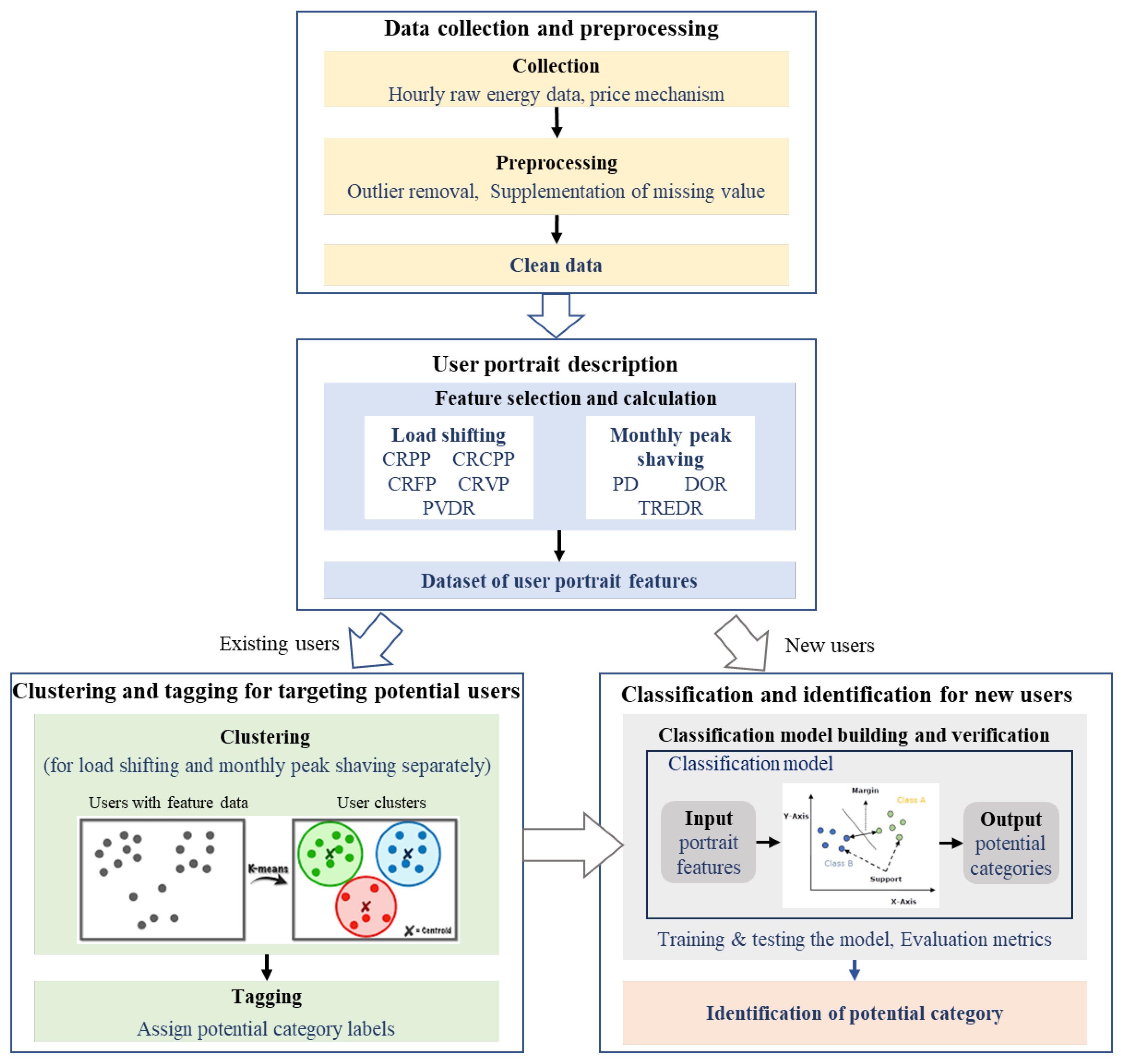


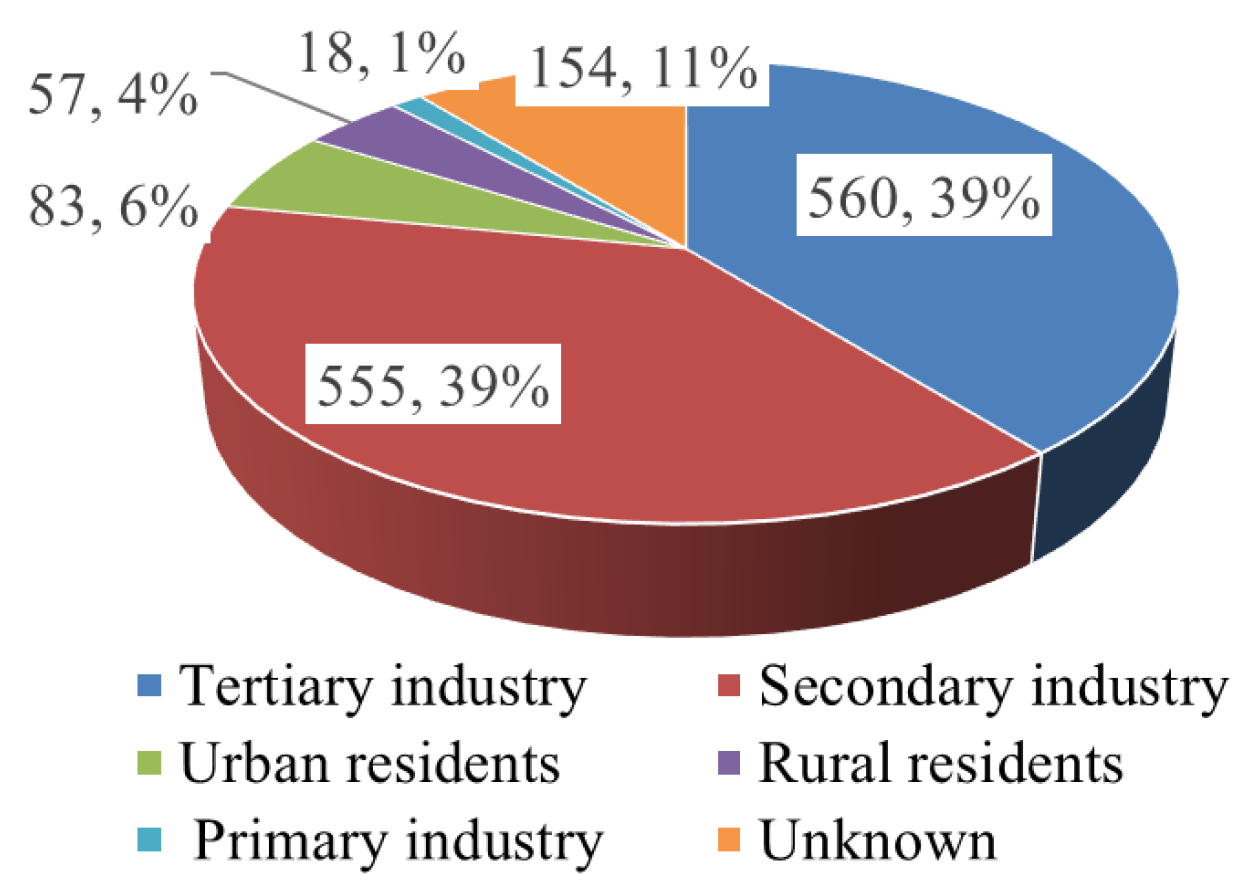
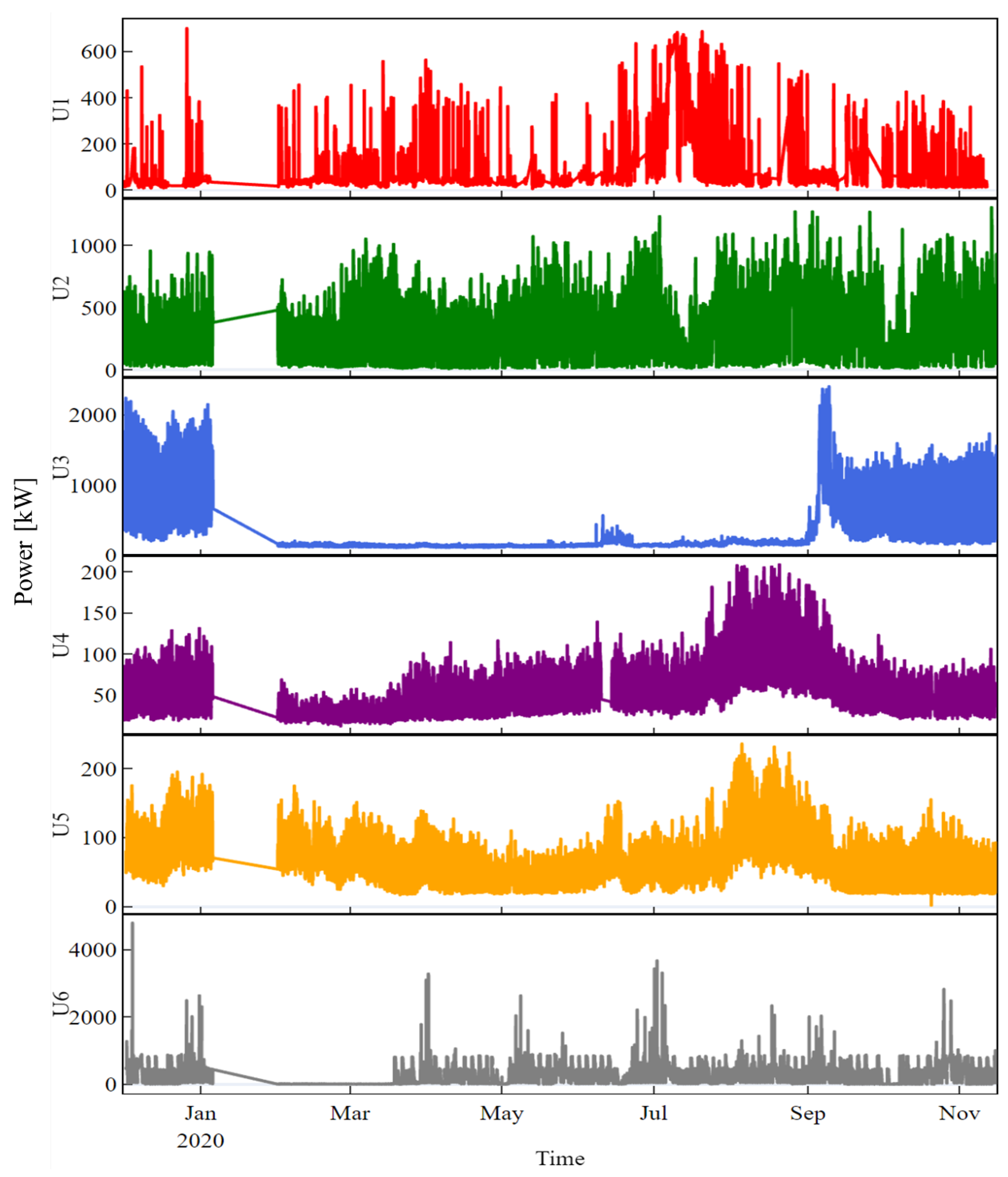
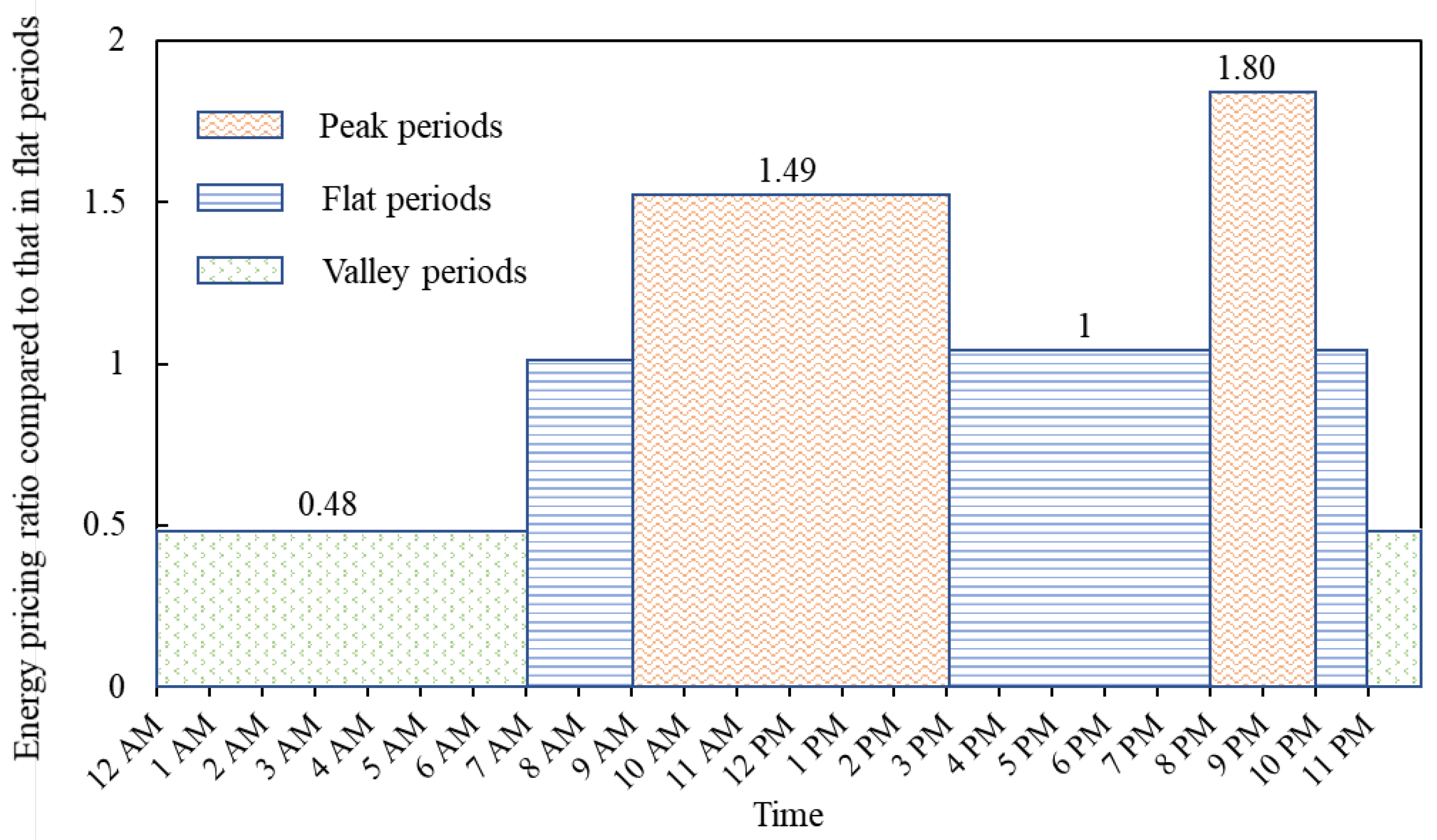

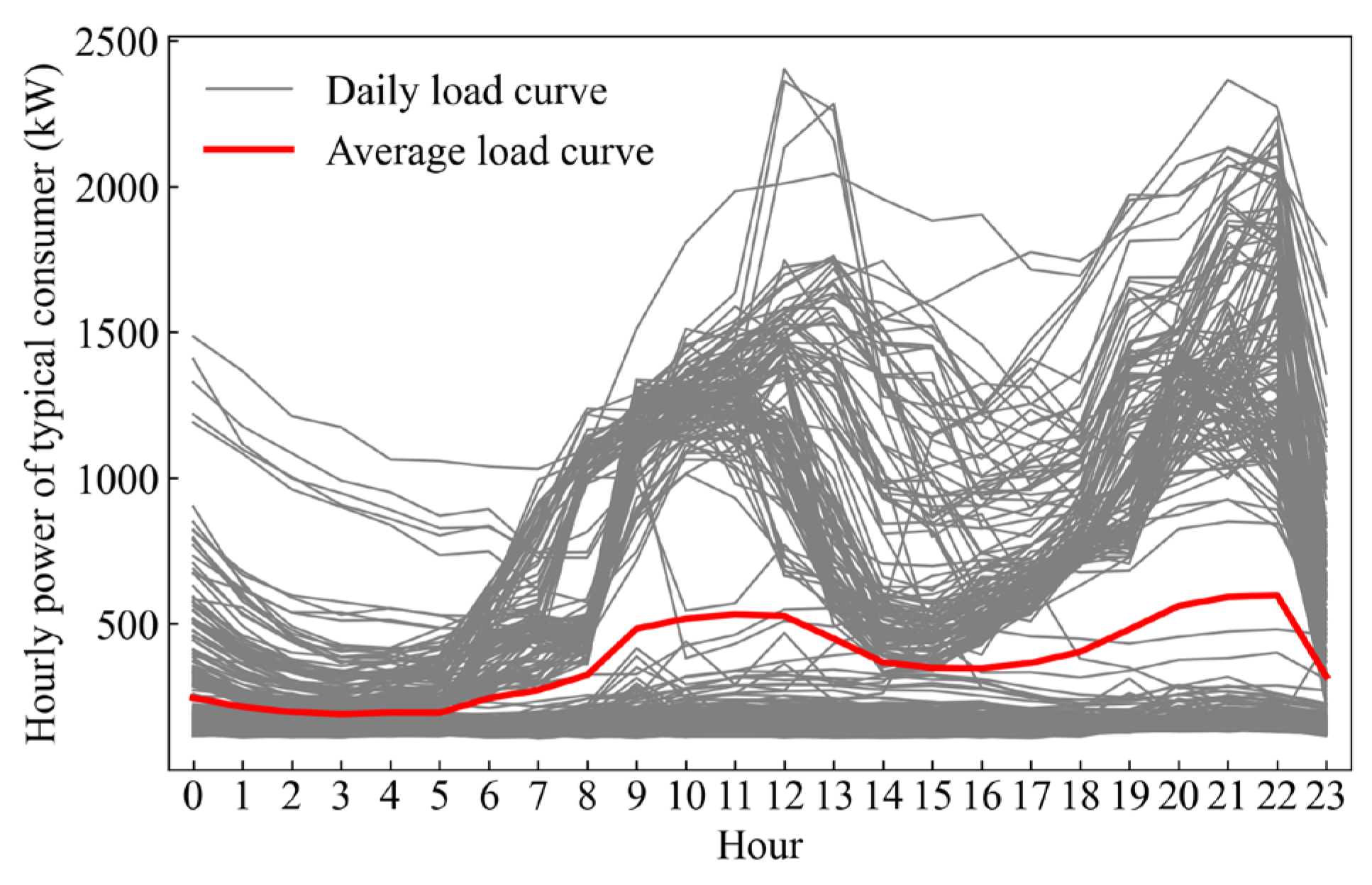
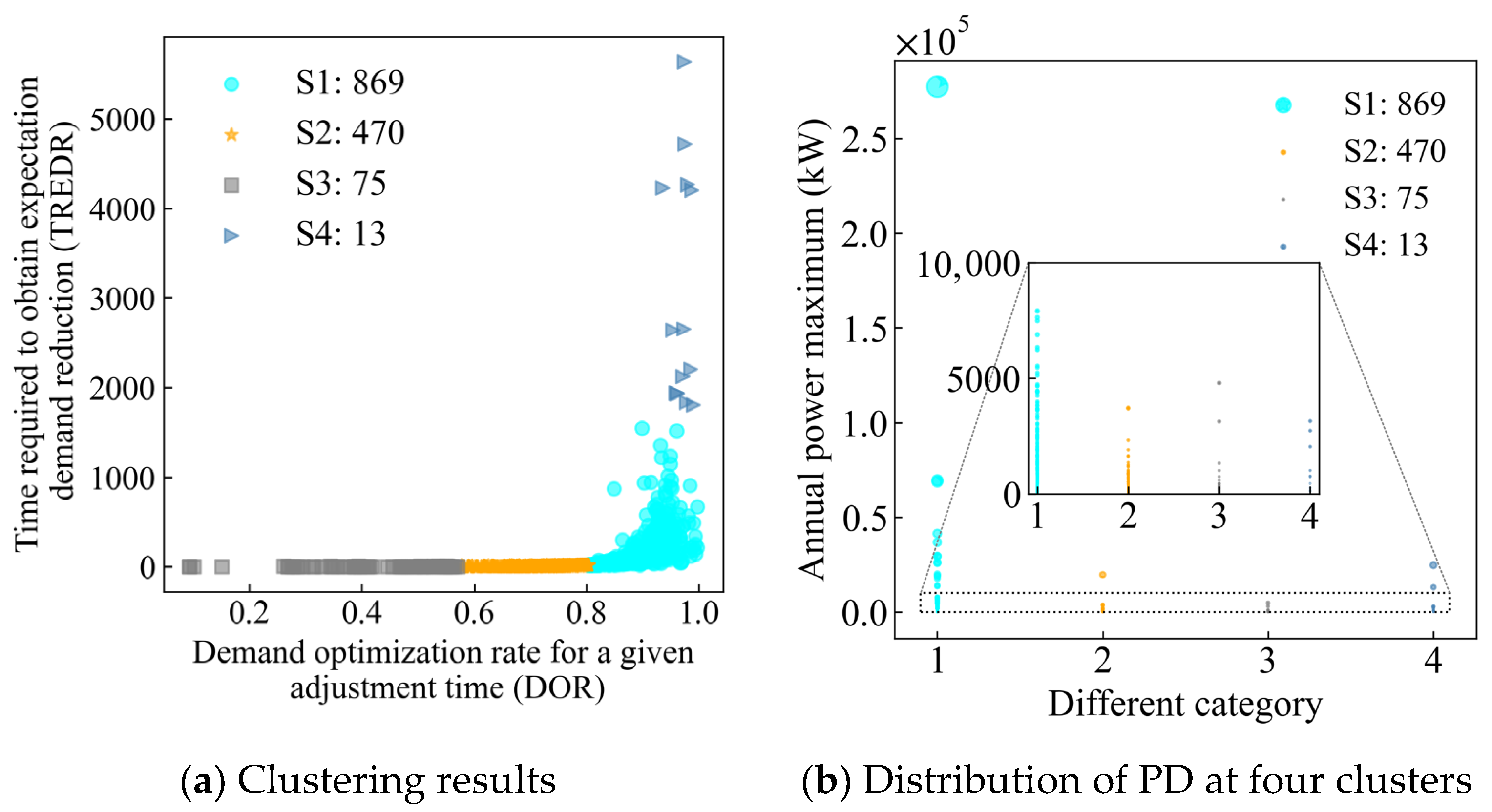

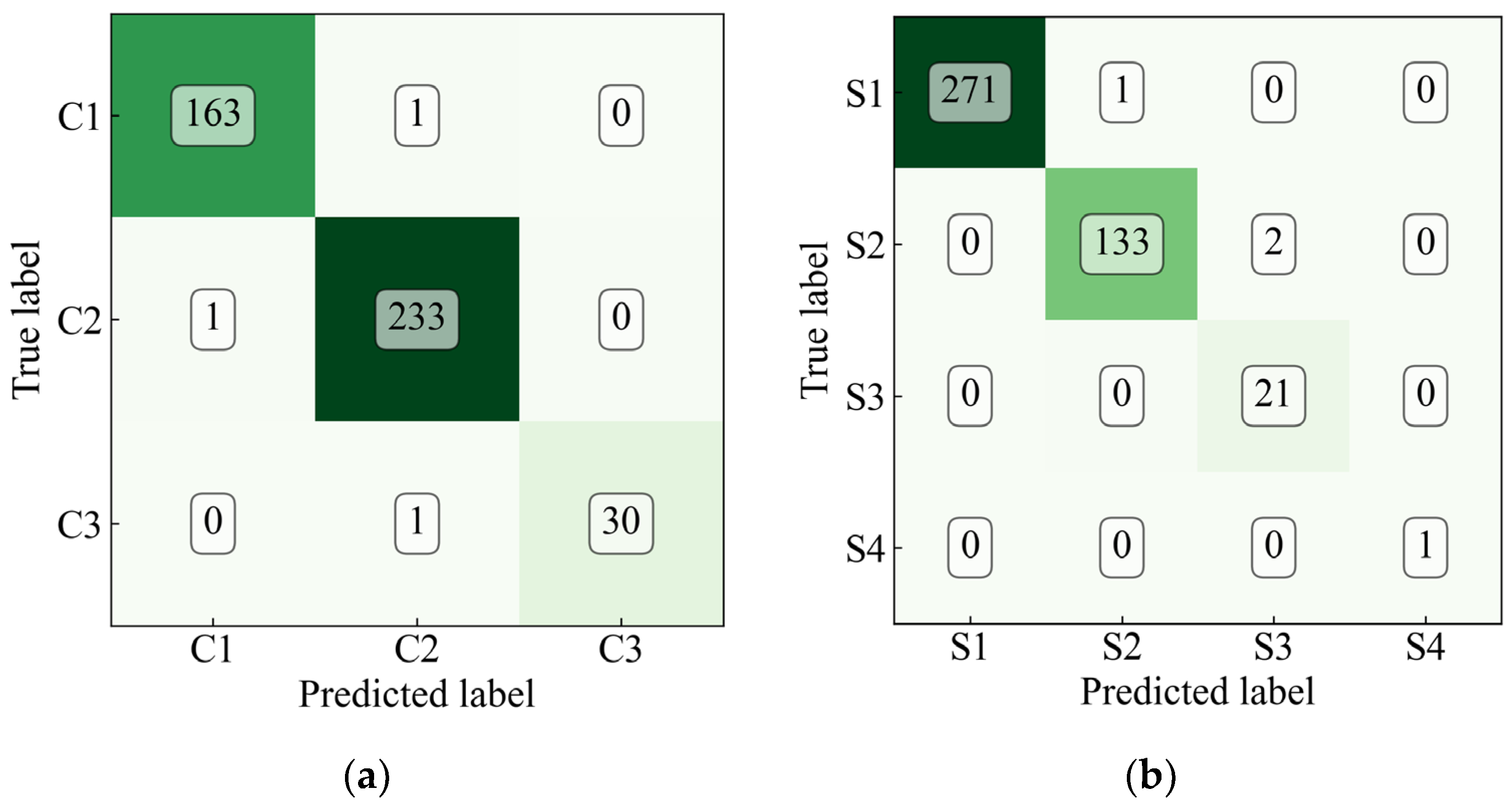
| Items | Accuracy for Classifying Load Shifting Potentials | Accuracy for Classifying Monthly Peak Shaving Potentials |
|---|---|---|
| Train set | 99.7% | 99.4% |
| Test set | 99.3% | 99.3% |
Disclaimer/Publisher’s Note: The statements, opinions and data contained in all publications are solely those of the individual author(s) and contributor(s) and not of MDPI and/or the editor(s). MDPI and/or the editor(s) disclaim responsibility for any injury to people or property resulting from any ideas, methods, instructions or products referred to in the content. |
© 2024 by the authors. Licensee MDPI, Basel, Switzerland. This article is an open access article distributed under the terms and conditions of the Creative Commons Attribution (CC BY) license (https://creativecommons.org/licenses/by/4.0/).
Share and Cite
Zhang, Y.; Ling, Z.; Liu, M.; Gang, W.; Su, L. An Energy Portrait-Based Identification Method of Building Users for Demand Response. Buildings 2024, 14, 2534. https://doi.org/10.3390/buildings14082534
Zhang Y, Ling Z, Liu M, Gang W, Su L. An Energy Portrait-Based Identification Method of Building Users for Demand Response. Buildings. 2024; 14(8):2534. https://doi.org/10.3390/buildings14082534
Chicago/Turabian StyleZhang, Ying, Zaixun Ling, Manjia Liu, Wenjie Gang, and Lihong Su. 2024. "An Energy Portrait-Based Identification Method of Building Users for Demand Response" Buildings 14, no. 8: 2534. https://doi.org/10.3390/buildings14082534
APA StyleZhang, Y., Ling, Z., Liu, M., Gang, W., & Su, L. (2024). An Energy Portrait-Based Identification Method of Building Users for Demand Response. Buildings, 14(8), 2534. https://doi.org/10.3390/buildings14082534





